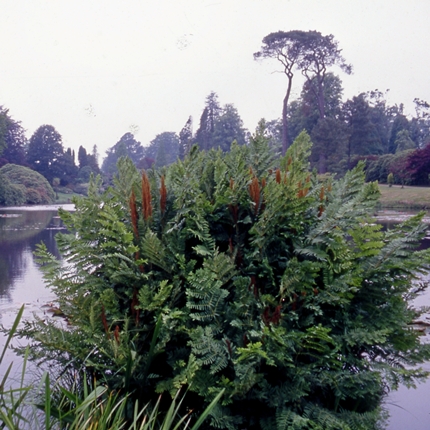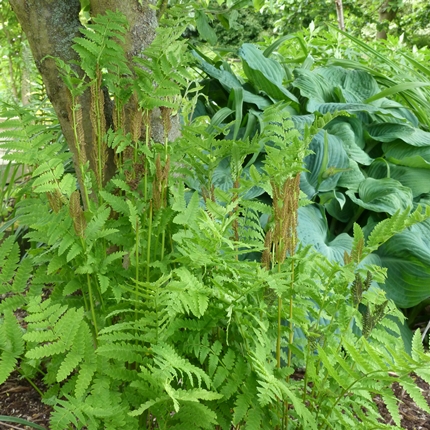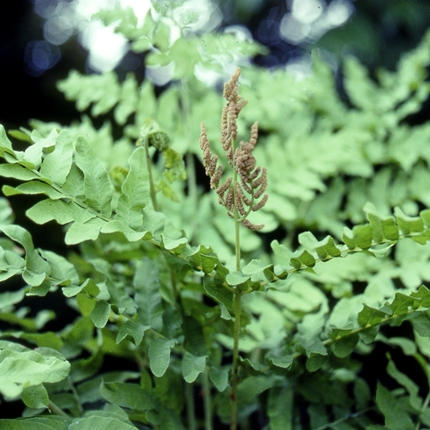Osmunda, or the royal ferns, is a very old genus. Fossil plants have been found which were almost certainly among the earliest large plants on land, and are very little different from the modern Osmundas which still grow today, I think that it is one of the joys of gardening that I can enjoy a view of plants growing by the waterside, which is little different from a view a primitive amphibian could have seen three hundred million years ago. Osmundas are also distinguished in that they have special fertile leaflets on some of the fronds, which look quite different from the normal pinna and often give the ferns an attractive appearance, as though they possessed seedheads. The spores are shed from these pre-germinated and are bright green in colour, they do not keep very long so must be sown fresh, but if caught quickly they are some of the easiest and fastest ferns you can grow from spores.
|

|
Osmunda claytoniana AGM (D) interrupted fern Hight/Spread 100cm.
This is a rather beautiful foreign species, of much softer appearance than O. regalis, and only about two thirds of the size. A good fern for a moist spot. It has its fertile pinnae in the middle of the frond, hence the name interrupted fern. |

|
Osmunda regalis AGM (D) royal fern, flowering fern Hight 150cm.
Perhaps our biggest British native, slow-growing to head hight or more and with a liking for a moist/wet soil and shade. It is among the largest garden ferns and is said to prefer acidic and moist soil conditions. The main character of Osmunda is that the sporangia are produced on separate pinnae which are often different from those on the rest of the frond, which is quite a striking and often colourful feature. O. regalis is always impressive and has an air of strength and masculinity, perhaps because the fronds, though large, are of simple bipinnate construction with large smooth pinnules, much like giant ash leaves. The fertile fronds come up in the centre of the plant, with the fertile pinnae on the tips, looking like the seed heads of docks or astilbes. This may account for the alternative name of ‘flowering fern’. It is much less common in the wild today than it used to be, but is still widely distributed, and I have seen 2m high thickets of it in deep wet valleys on the North Yorkshire Moors, as well as plants an eighth that size growing on the cliff faces of Lundy island. It is widely thought to be intolerant of lime, but since it grows vigorously in my own garden this plainly is not true. There is a highly variable, purple-stemmed form called ‘Purpurascens’ commonly on sale and well worth buying since it seems to me to have more vigour and be quicker growing than the type, which some consider to be a subspecies. There are also crested and crisped forms, which can be hard to find in the trade, and are not especially distinct. |

|
|